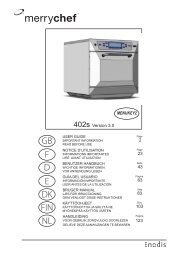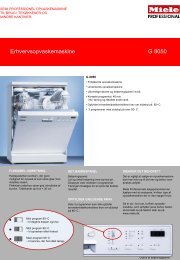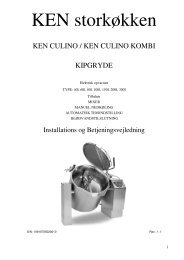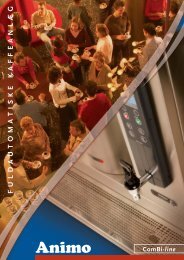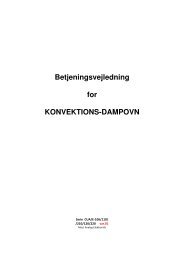DK Mekanisk mikrobølgeovn ............................................................
DK Mekanisk mikrobølgeovn ............................................................
DK Mekanisk mikrobølgeovn ............................................................
Create successful ePaper yourself
Turn your PDF publications into a flip-book with our unique Google optimized e-Paper software.
Summary of the five power steps:<br />
HIGH (full power) 100 %<br />
M. HIGH (medium-high power) 77 %<br />
MED (medium power) 55 %<br />
M. LOW (medium-low power) 36 %<br />
DEFROST 36 %<br />
LOW (low power) 17 %<br />
TIPS FOR FOOD PREPARATION<br />
When preparing food in a microwave oven, the following basic rules apply:<br />
Cooking time<br />
Smaller quantities of food cook more rapidly than large quantities. If the amount of<br />
food is doubled, the preparation time must correspondingly be more than doubled.<br />
Small pieces of meat, small fish and chopped vegetables cook more quickly than<br />
large pieces. For the same reason, it is recommended, if, for example, you wish to<br />
make goulash, stews or similar, that the meat be cut into pieces no bigger than 2 x<br />
2 cm.<br />
The compactness of the food is also very important for the cooking time. The more<br />
compact the food is, the longer it takes to cook.<br />
• Whole joints require a longer cooking time than stewed dishes.<br />
• A joint requires a longer time than a dish using minced meat.<br />
The colder the food, the longer the cooking time needs to be. Food at room<br />
temperature will therefore cook faster than food from a fridge or freezer.<br />
When cooking vegetables, the cooking time depends on the freshness of the<br />
vegetables. Therefore, check the condition of the vegetables, and add or deduct a<br />
little time accordingly.<br />
The short cooking time when using a microwave oven means that the food does not<br />
overcook.<br />
• If required, a little water can be added.<br />
• When cooking fish and vegetables, you only need to use the minimum of water.<br />
Microwave power<br />
The choice of power setting depends on the condition of the food to be cooked.<br />
In most cases, the food is cooked on full power.<br />
• Full power is used, among other things, for reheating food quickly, boiling water<br />
or similar.<br />
• Low power is principally used to defrost food and prepare dishes containing<br />
cheese, milk or egg. (Whole eggs in their shell cannot be cooked in a microwave<br />
oven, as there is a risk of the eggs exploding.) In addition, lower power settings<br />
are also used to finish off and to retain the excellent aroma of a dish.<br />
General information on cooking<br />
• When preparing bag microwave popcorn, use an ovenproof dish suited for use<br />
in microwave ovens to protect the glass plate from shattering.<br />
• If the entire meal is to be cooked in a microwave oven, it is recommended that<br />
you start with the most compact foods, such as potatoes. Once these are ready,<br />
cover them while the rest of the food cooks.<br />
• Most food should be covered. A close-fitting cover retains the steam and<br />
moisture, which shortens the cooking time in the microwave oven. This is<br />
particularly the case when cooking vegetables, fish dishes and casseroles.<br />
Covering food also distributes the heat better, thus ensuring rapid and excellent<br />
results.<br />
• In order to achieve the best possible results, it is important to position the food<br />
correctly, as the microwave rays are most powerful at the centre of the oven<br />
compartment. If, for example, you are baking potatoes, you should position<br />
them along the edge of the glass turntable so that they cook evenly.<br />
• In order to cook compact dishes such as meat and poultry evenly, it is important<br />
to turn the pieces of meat a few times.<br />
• You can bake in a microwave oven, although not with recipes that include yeast.<br />
• When preparing food with a thick skin, e.g. potatoes, apples, whole squash or<br />
chestnuts, you should prick holes in the skin to prevent the food from bursting<br />
during cooking.<br />
• When preparing food in a “traditional” oven, you normally avoid opening the<br />
oven door as much as possible. This is not the case with microwaves: no energy<br />
or significant heat is lost. In other words, you can open the oven door and look<br />
at the food as often as you want.<br />
Important safety measures when preparing food<br />
• If using the microwave oven to heat baby food or liquids in a feeding bottle, you<br />
must always stir the food/liquid and check the temperature thoroughly before<br />
serving. This ensures that the heat is evenly distributed and avoids scalding<br />
injuries.<br />
The lid and/or teat must NOT be fitted on a feeding bottle when it is placed in<br />
the microwave oven.<br />
• If some foods are heated too long, they may char and give off smoke. If this<br />
happens, you should leave the oven door closed and switch off the microwave<br />
oven completely.<br />
• Some foods with low water content, e.g. chocolate in squares and pastries with<br />
a sweet filling, should be heated carefully, otherwise they or the container may<br />
be ruined.<br />
15<br />
USING UTENSILS WHEN PREPARING FOOD<br />
Before starting to prepare food in containers, you should check that the containers<br />
you wish to use are made of a suitable material, as some types of plastic may<br />
become limp and deform, while some types of ceramics may crack (particularly<br />
when heating small quantities of food).<br />
In order to test if a container is suitable for use in a microwave oven:<br />
• Place the container in the appliance.<br />
• At the same time, place a half-full glass of water in the container.<br />
• Start, and run for 15-30 seconds on maximum power.<br />
• If the container becomes very hot to the touch, do not use it.<br />
Suitable utensils and materials<br />
When cooking food in a microwave oven, you should PREFERABLY use the<br />
following utensils and materials:<br />
• Glass and glass bowls<br />
• Stoneware (glazed and unglazed). The food stays hot longer in glazed<br />
stoneware than in other dishes.<br />
• Plastic containers. Can be used for many heating purposes. Caution! Plastic<br />
containers made from melamine, polyethylene and phenol must NOT be used.<br />
• Porcelain. All porcelain can be used in the microwave oven, although fireproof<br />
porcelain is preferable.<br />
• Fireproof covered dishes. Glass dishes with lids that fit so closely that steam<br />
cannot escape are ideal for vegetables and fruit to which no liquid is added<br />
(however, the cooking time must not exceed 5 minutes).<br />
• Browning dishes You must be very careful when using this type of dish. Never<br />
heat the browning dish for more than 5 minutes on the turntable. Suitable<br />
insulation, such as a heat-tested plate, should be placed between the browning<br />
dish and the turntable to prevent the turntable from overheating.<br />
• Microwave roasting film can be used, particularly for soups, sauces, stewed<br />
dishes or when defrosting food. Can also be used as a loose covering to prevent<br />
fat, etc. from spraying out into the oven compartment.<br />
• Kitchen roll is ideal, as it absorbs moisture and fat. For example, bacon can<br />
be placed in layers, with kitchen roll between each layer. The bacon will then<br />
be completely crispy, as it does not sit in its own fat. Home-baked bread can<br />
be taken directly from the freezer, wrapped in kitchen roll and heated in the<br />
microwave oven.<br />
• Wet kitchen roll can be used for fish or vegetables. Covering the food prevents<br />
it from drying out.<br />
• Greaseproof paper Fish, large vegetables, such as cauliflower, corn on the cob<br />
and similar can be wrapped in wet greaseproof paper.<br />
• Roasting bags are ideal for meat, fish and vegetables. However, they must<br />
never be closed using metal clips. Cotton thread should be used instead. Prick<br />
the bag with small holes, and place it in the microwave oven on a plate or glass<br />
dish.<br />
Unsuitable utensils and materials<br />
When cooking food in a microwave oven, you must NOT use the following utensils<br />
and materials:<br />
• Sealed glass jars/bottles with small openings, as they may explode.<br />
• General-purpose thermometers<br />
• Silver foil/foil trays, as the microwave rays cannot penetrate the material and<br />
the food will not cook.<br />
• Recycled paper, as it may contain small metal splinters that could cause<br />
sparks and/or fire.<br />
• Closed tins/containers with tightly sealed lids, as excess pressure may cause<br />
the tin/container to explode.<br />
• Metal clips and lids/film containing metallic threads since they can cause sparks<br />
in the microwave oven and must therefore be removed.<br />
• Metal bowls/containers and packaging, unless they are designed specifically<br />
for use in microwave ovens. The microwaves are reflected and cannot penetrate<br />
the food through the metal.<br />
• Plates, dishes and bowls/containers with metal, gold and silver<br />
decorations. They may break and/or cause sparks to form in the oven<br />
compartment.<br />
CLEANING<br />
When cleaning the appliance, you should pay attention to the following points:<br />
• Turn off the appliance and remove the plug from the wall socket before cleaning.<br />
• Clean the appliance by wiping it with a damp cloth. A little detergent can be<br />
added if the appliance is heavily soiled.<br />
• Do not use scouring pads, steel wool or any form of strong solvents or abrasive<br />
cleaning agents to clean the appliance, as they may damage the outside<br />
surfaces of the appliance.<br />
• Make sure that no water gets into the vent holes.<br />
• The turning ring and the floor of the microwave oven must be cleaned regularly<br />
so that the glass turntable can move around without hindrance.<br />
• Be aware that leaving greasy residue and/or spills on the glass turntable can<br />
cause it to overheat and shatter.<br />
• The glass turntable can be cleaned in a dishwasher.<br />
• Do not remove the mica plate from the inside of the oven!<br />
• Tip: When the appliance has been in use for some time, the oven compartment<br />
can begin to smell. If the smell is not dispersed by ordinary cleaning, place a few<br />
lemon slices in a cup and cook them in the microwave oven at full power for 2-3<br />
minutes. This will effectively disperse the smell.



